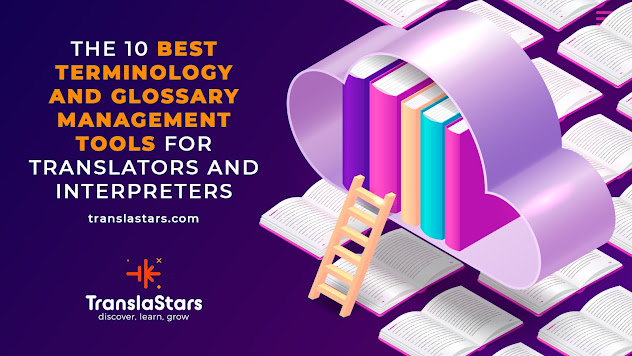The 10 best terminology and glossary management tools for translators and interpreters
The 10 best terminology and glossary management tools for translators and interpreters
Tired of using pointlessly complex and boring Excel glossaries to prepare for the next translation or interpreting assignment?
Here is a list of the 10 best terminology and glossary management tools for translators and interpreters to help you improve the quality of your work, respect your clients’ guidelines, ensure consistency across the whole project, save time and avoid mistakes.
Index
Gloss It
Glossaries2go
Interpretbank
flashterm
Interpreters’ help
Translate Toolkit
SDL MultiTerm Extract
Sketch Engine
Terminus
TermSuite
1. Gloss It
Gloss It is an intuitive and collaborative glossary platform that makes your glossaries better organized and accessible to everyone involved in the translation process of any text, no matter how big or small it is.
Before reviewing the entire text, it ensures consistency of terms as a core part of the translation and reviews and accepts glossary terms. This way the basis of a high-quality translation will be approved in advance and will save you headaches in post-editing and proofreading.
Also, this glossary management system recently launched Term Hunter, a brand-new tool designed to help you speed up your translation process. When working with a glossary, this tool will locate all the terminology in the source text for you and add its translation right next to it.
Term Hunter will detect all the terms for you, so you won't have to worry about whether a word is in the glossary or not. This will allow you to focus completely on your writing.
Gloss It offers small, medium, and advanced monthly or annual plans for you to access its features, including a free plan for you to get familiar with it. In addition, if you subscribe, use the code TRANSLASTARS25 to get 50% off for a year.
PRO TIP: Do you want to see how Gloss It can improve your daily life as a language professional?
Have a look at the medical translation glossaries that Pablo Mugüerza created using Gloss It or join us on May 17 for a free webinar with Sergio Rebollo, Gloss IT CEO, software developer and translator.
Remember to add this event to your calendar so you don’t miss it!
 |
| Pablo Mugüerza's glossary on TranslaStars.es |
2. Glossaries2go
Glossaries2go is a very easy and user-friendly app for Android and iPhone that helps you carry all your glossaries with you and access them anywhere, anytime.
You can create glossaries in .xlsx or .csv and upload them to your phone using a cloud-based storage account (such as iCloud, Google Drive or Dropbox) and update them on the go.
In the app, you can set filters to help you find the right word or just prepare for your next interpreting assignment while you’re away from your computer.
Both a paid and a free version are available.
3. Interpretbank
Interpretbank is computer-assisted interpreting tool for Mac or Windows computers designed by interpreters for interpreters.
It helps you create a cloud glossary database that everyone with the weblink is able to access from any mobile device and search through it in a fast and reliable way.
The free trial lasts 14 days, but you can convert to one of its two paid plans anytime. The Freelance plan costs €9.99/ month or €249.99 for the one-time license, while the Enterprise plan costs €29.99/month plus monthly database management fees.
 |
| This is how InterpretBank looks on Windows. Source: https://interpretbank.com/ |
4. flashterm
flashterm is a collaborative terminology and knowledge management system that you and the language professionals you work with can access either from within your company or from any location worldwide via PC, Mac, iPad, iPhone or browser.
Flashterm comes with 195 predefined languages, but its team promises to add more as needed. You can choose from this pool of languages your own source and target languages, as well as any additional languages you wish to support.
You can browse through your glossaries using a wide range of filters, add more information to each entry (such as synonyms, variants, abbreviations, inflections, illustrations, contextual information, additional information, etc) and group them into various subject areas and categories.
flashterm is available in many different versions, for single users or networks. To find out the pricing, visit their contact page.
5. Interpreters’ help
Interpreters’ help is specifically designed to help interpreters save time by:
- Creating and importing glossaries online
- Managing terminology and jobs
- Sharing glossaries with colleagues or its community
- Extracting terms from text really fast to build glossaries.
You can also use it to consult dictionaries, learn and review glossaries with flashcards, and contribute to its mission to build the largest glossary database for interpeters ever.
 |
| Interpreters' Help public glossaries database. |
6. Translate Toolkit
Translate Toolkit is a free software that helps localization engineers and translators convert, count, manipulate, review and debug texts.
It is known as the localization engineers' Swiss Army Knife. By modifying the code, you can add customized formats, project types, localization tests, and language modules to it that fit your needs.
If you don’t know how to code, it’s also useful to perform bilingual term extraction, which is extremely helpful for building glossaries.
7. SDL MultiTerm Extract
SDL MultiTerm Extract is probably the most well-known terminology extraction tool designed for translators.
It supports all languages, including Unicode, and can be used to locate monolingual and bilingual terminology in documents and translation memories.
As part of its integration with SDL Trados Studio, you can also manually add a variety of information to the terms (such as synonyms, context, definitions, illustrations, part-of-speech tags, and URLs), and search thourgh the terms' descriptive fields.
It is included for free when you purchase any Trados Studio license.
8. Sketch Engine
Sketch Engine is an online tool created for building and managing corpora, which includes terminology extraction.
It supports 82 languages and offers both monolingual and multilingual extraction. In monolingual terminology extraction, the user can choose whether to extract single words or multi word terminological units.
You can try the 30-day free trial and then upgrade to a paid commercial or academic license.
 |
| Sketch Engine's dashboard. |
9. Terminus
Terminus is a web-based application for corpus and terminology management developed at the University Pompeu Fabra in Spain.
The purpose of this tool is to integrate the complete process of terminographic work: textual corpus search, compilation and analysis, term extraction, glossary and project management, database creation and maintenance, and dictionary edition.
It offers academic, research group or individual licenses.
10. TermSuite
TermSuite is an open source software developed at the University of Nantes.
This tool is more complicated to use than others, but it can handle NLP preprocessing, terminology extraction, and multilingual alignment in six languages: English, French, German, Spanish, Chinese and Russian.
PRO TIP: Do you spend hours searching for the best term only to feel overwhelmed and unsure?
Enroll in our course “Translating Terminology. Best Resources for Complex Texts” to discover the best terminology resources and tools for translating official documents and develop a terminology management plan to make your translation process more efficient.
Did you enjoy reading this blog post? Buy us a coffe!


.jpg)


betmatik
ReplyDeletekralbet
betpark
tipobet
slot siteleri
kibris bahis siteleri
poker siteleri
bonus veren siteler
mobil ödeme bahis
A54
canlı sex hattı
ReplyDeleteheets
https://cfimi.com/
salt likit
salt likit
AAAG7C
This blog provides an insightful overview of the top 10 terminology and glossary management tools for translators and interpreters. It highlights tools like Gloss It, Glossaries2go, and Interpretbank that enhance workflow efficiency, ensuring consistency and accuracy across translation projects. These tools are essential for professionals seeking to streamline their work and avoid errors. Read more
ReplyDeleteشركة عزل اسطح بجدة
ReplyDeleteESyPfkIySZ